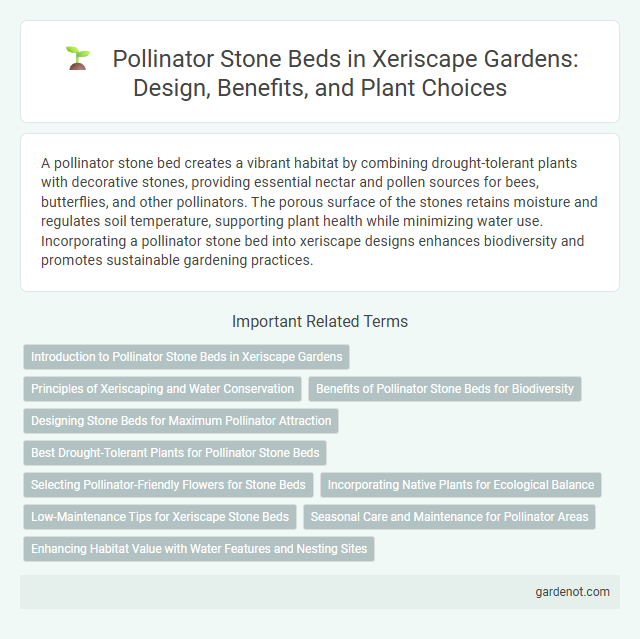A pollinator stone bed creates a vibrant habitat by combining drought-tolerant plants with decorative stones, providing essential nectar and pollen sources for bees, butterflies, and other pollinators. The porous surface of the stones retains moisture and regulates soil temperature, supporting plant health while minimizing water use. Incorporating a pollinator stone bed into xeriscape designs enhances biodiversity and promotes sustainable gardening practices.
Introduction to Pollinator Stone Beds in Xeriscape Gardens
Pollinator stone beds in xeriscape gardens create a vital habitat for bees, butterflies, and other beneficial insects by combining drought-tolerant plants with strategically placed stones that retain moisture and provide shelter. These beds promote biodiversity while conserving water in arid landscapes, aligning perfectly with xeriscape principles. Integrating native flowering species within pollinator stone beds enhances pollination efficiency and supports local ecosystems.
Principles of Xeriscaping and Water Conservation
Pollinator stone beds exemplify the principles of xeriscaping by integrating drought-tolerant plants with permeable surfaces that minimize water runoff and evaporation. These designs prioritize native pollinator-friendly flora, enhancing biodiversity while significantly reducing irrigation needs. Incorporating stone beds supports water conservation by promoting efficient water use and maintaining soil moisture, essential for sustainable xeric landscapes.
Benefits of Pollinator Stone Beds for Biodiversity
Pollinator stone beds create essential habitats that support diverse pollinator species by providing shelter, nesting sites, and microclimates crucial for bees, butterflies, and other insects. These stone beds enhance local biodiversity by promoting pollination of native plants, leading to healthier ecosystems and increased plant reproduction. Incorporating pollinator stone beds into xeriscapes reduces water usage while sustaining vital pollinator populations that contribute to ecological balance.
Designing Stone Beds for Maximum Pollinator Attraction
Designing stone beds for maximum pollinator attraction involves selecting native flowering plants that bloom sequentially throughout the growing season to provide continuous nectar and pollen sources. Incorporating varied stone sizes and textures creates microhabitats preferred by different pollinators such as bees, butterflies, and beetles. Positioning stone beds in sunny, sheltered locations enhances warmth and accessibility, boosting pollinator visitation rates and promoting biodiversity.
Best Drought-Tolerant Plants for Pollinator Stone Beds
Best drought-tolerant plants for pollinator stone beds include native succulents like Sedum and Echeveria, which attract bees and butterflies while thriving in low-water conditions. Lavender and Russian sage provide vibrant blooms and strong fragrances that boost pollinator activity and withstand arid environments. Incorporating drought-resistant flowering perennials such as Blanket flower (Gaillardia) enhances the stone bed's ecological value and conserves water resources effectively.
Selecting Pollinator-Friendly Flowers for Stone Beds
Selecting pollinator-friendly flowers for a pollinator stone bed involves choosing native, drought-tolerant species that thrive in rocky, well-drained soil while providing nectar and pollen. Popular options include coneflowers, lavender, and blanket flowers, which attract bees, butterflies, and hummingbirds, enhancing biodiversity. Integrating these plants into xeriscape designs reduces water use and supports local pollinator populations effectively.
Incorporating Native Plants for Ecological Balance
Pollinator stone beds enhance xeriscape gardens by integrating native plants that support local ecosystems. These native species provide essential habitats and food sources for bees, butterflies, and other pollinators, promoting biodiversity and ecological balance. Using drought-tolerant, native flora ensures water efficiency while sustaining pollinator populations crucial for plant reproduction and ecosystem health.
Low-Maintenance Tips for Xeriscape Stone Beds
Xeriscape stone beds benefit from using native, drought-tolerant plants that attract pollinators like bees and butterflies, reducing water consumption while supporting biodiversity. Applying a layer of organic mulch beneath stone surfaces helps retain soil moisture and suppress weeds, minimizing maintenance efforts. Regularly removing debris and dead plant material ensures optimal airflow and prevents pest infestations, contributing to a thriving, low-maintenance pollinator habitat.
Seasonal Care and Maintenance for Pollinator Areas
Seasonal care for pollinator stone beds involves regular inspection to remove invasive weeds and debris, ensuring unobstructed access to nectar sources. Watering should be minimal, relying on drought-tolerant plants while monitoring soil moisture during dry spells to prevent stress. Pruning spent blooms and replenishing native wildflowers in early spring promotes continuous pollinator activity throughout the growing season.
Enhancing Habitat Value with Water Features and Nesting Sites
Pollinator stone beds enhance habitat value by incorporating water features such as shallow basins or drip edges that provide essential hydration for bees and butterflies. Integrating nesting sites like bee blocks or hollow stems within the stone bed offers sheltered breeding areas critical for native pollinator reproduction. These elements collectively create a resilient ecosystem promoting biodiversity and sustainable xeriscape landscaping.
Pollinator stone bed Infographic

 gardenot.com
gardenot.com